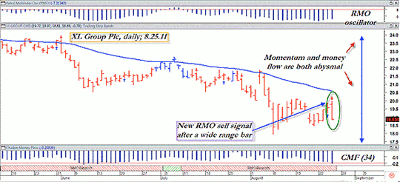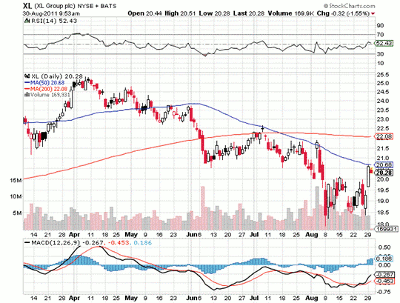The charts and a well-known trading system suggest more downside ahead for insurance giant XL Group (XL), and with an important price low nearby, short-side traders can lock in some profits and let the winner run.
XL Group (XL), one of the global insurance giants, has seen its share price steadily erode since peaking in early-April 2011. In the time since then, the shares have gradually declined from $25.43 to $18.85, even taking out the very significant November 2010 swing low of $19.36 in the process.
In the past few trading sessions, XL has bounced up to around the $20.25 area.
Currently, the stock appears to be on track to do either of two things:
- Make a double bottom and continue its brief rally up toward major resistance near $21.88, or…
- Continue to drop, taking out the August 8, 2011 swing low of $17.84 en route to even lower valuations.
One look at the daily graph for XL (Figure 1 below) makes a very convincing case that the brand new Rahul Mohindar Oscillator (RMO) swing sell signal in the stock may very well have enough downward pressure bearing upon it (negative money flow and momentum trends) to put it even deeper into the coal mine of plunging stock prices over the course of the next few weeks (or months).
The stock is also burdened by its very poor relative strength ranking against SPX over the past calendar quarter (13 weeks), making this new RMO swing sell signal even more appealing to aggressive equities market traders.
Prices are also under their 50-day simple moving average (SMA), which seems to be acting as resistance—yet another technical factor that seems to put the near-term trend bias for XL into the bearish camp.
While the RMO trading system in MetaStock 11 is generally viewed by traders as a trend-following system, there certainly is no reason why enterprising traders couldn't elect to take some profits on their short positions if XL decided to retest that major low at $17.94.
That price area is sure to be a battleground between the bulls and the bears—should the stock even fall that far after being shorted—allowing for shrewd traders to lock in some gains as they bring their stop-loss down to at least break even, thus virtually ensuring a risk-free trade (at that point).
In crazy, volatile markets, you need to be prepared to act quickly to preserve open profits, prevent needless losses, and to keep your trading account equity curve growing at a steady rate.
By Don Pendergast of Linear Trading Systems LLC




















